Easy 15-Minute Thai Peanut Noodles Recipe
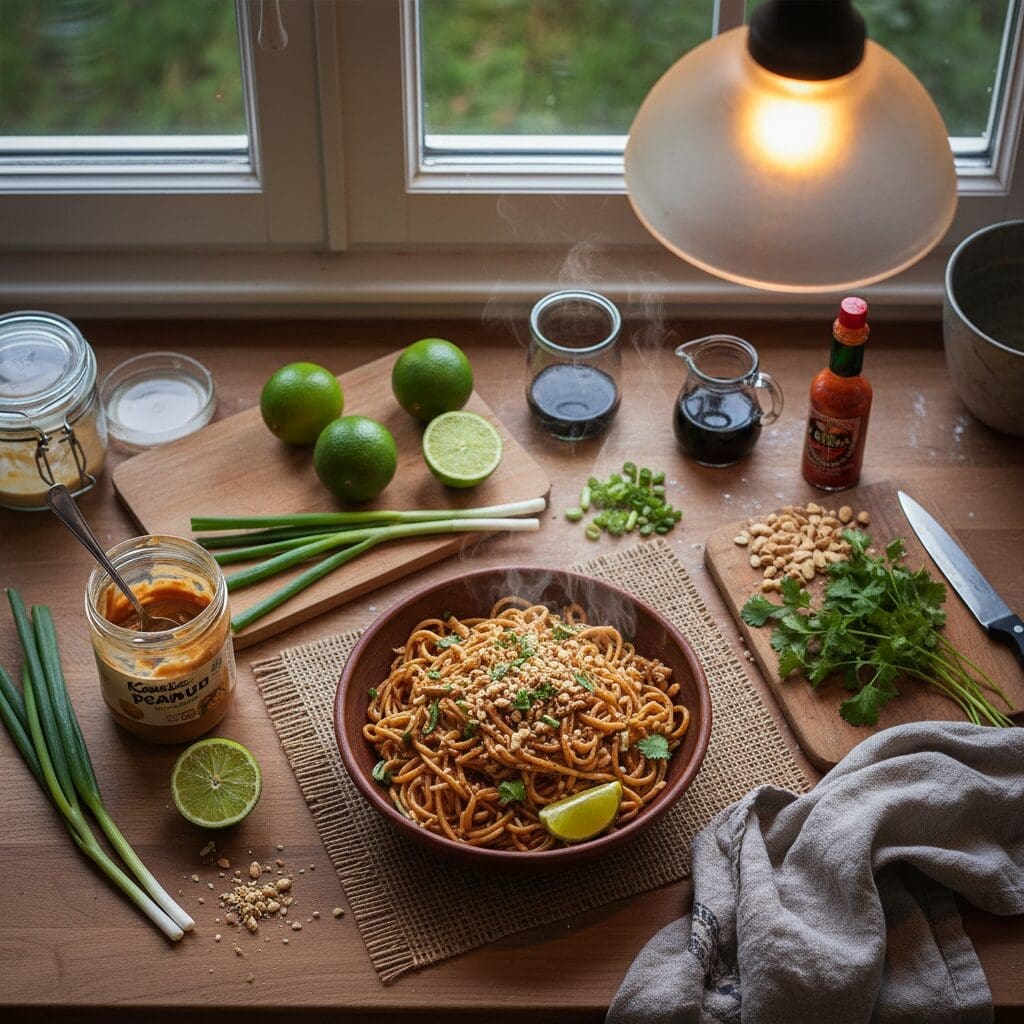
If you’re craving a comforting, flavorful meal that doesn’t require hours in the kitchen, these Thai Peanut Noodles are your new go-to. As a busy home cook, I’ve perfected this recipe over years of experimenting with quick vegan dinners, and it never fails to satisfy.
Inspired by classic Thai flavors, this dish combines creamy peanut sauce with al dente noodles and crisp vegetables for a balance of textures and tastes that’s both nourishing and indulgent. What sets it apart?
It’s made with everyday ingredients you likely already have, takes minimal effort, and packs in plant-based protein to keep you full. Whether you’re a vegan, vegetarian, or just love Asian-inspired eats, this recipe delivers takeout quality at home without the wait or the cost.
Let’s dive into why this will become your weeknight staple and how to make it effortlessly.
Why You’ll Love These Thai Peanut Noodles
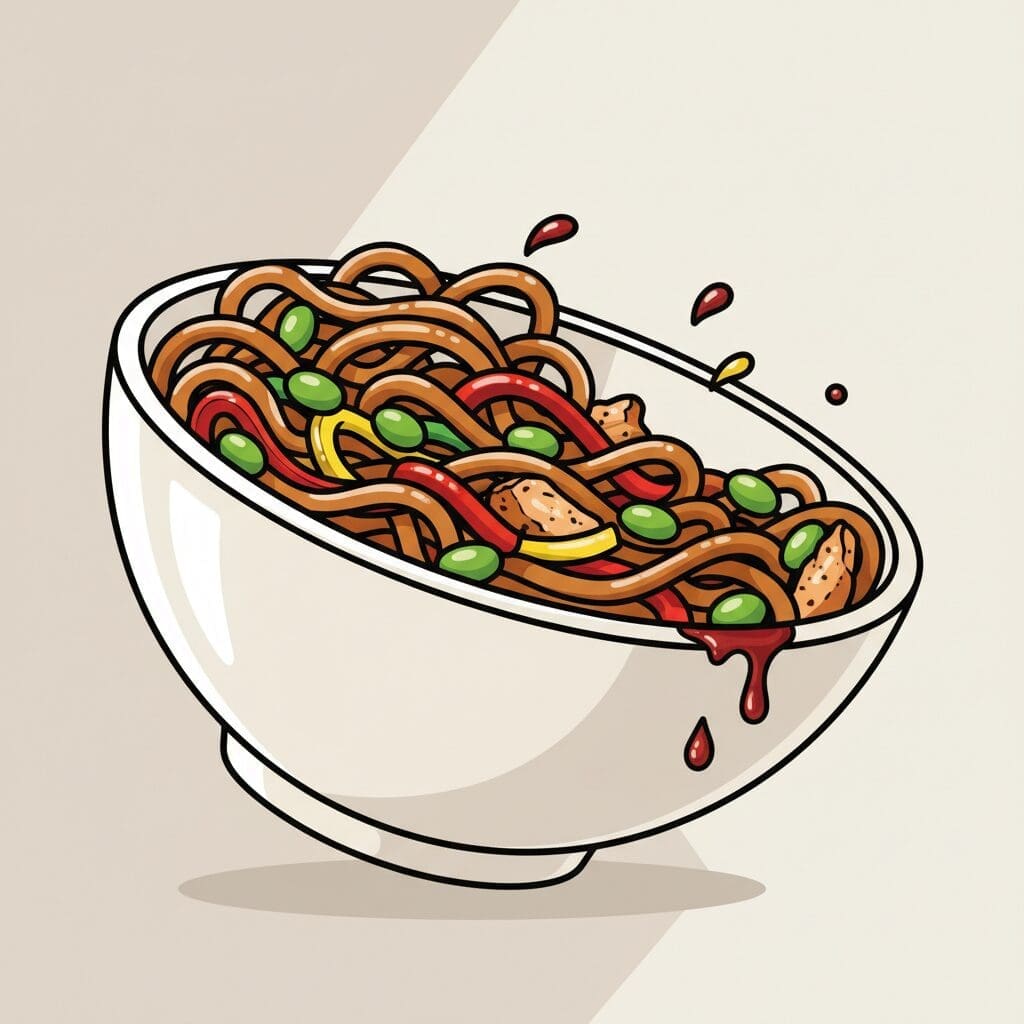
This recipe isn’t just another quick meal—it’s designed for real life. Here’s what makes it stand out:
- Lightning-Fast Prep: From start to finish, you’re eating in 15 minutes, perfect for those hectic evenings when cooking feels like a chore.
- Budget-Friendly Comfort: Using pantry staples like peanut butter, soy sauce, and pasta, it costs pennies per serving compared to ordering in.
- Customizable and Versatile: Swap veggies based on what’s in your fridge, add protein like tofu for heartiness, or dial up the spice—it’s forgiving for beginners and pros alike.
- Nutrient-Dense Yet Indulgent: Loaded with fiber-rich veggies and protein from edamame, it supports steady energy without the post-meal crash. Plus, the creamy sauce makes it feel like a treat.
- Leftover Magic: Tastes even better the next day, making it ideal for meal prep or packing lunches.
Drawing from my experience testing countless noodle dishes, this one hits the sweet spot of ease and satisfaction, much like my popular Teriyaki Noodles but with that signature Thai peanut twist.
Ingredients You’ll Need
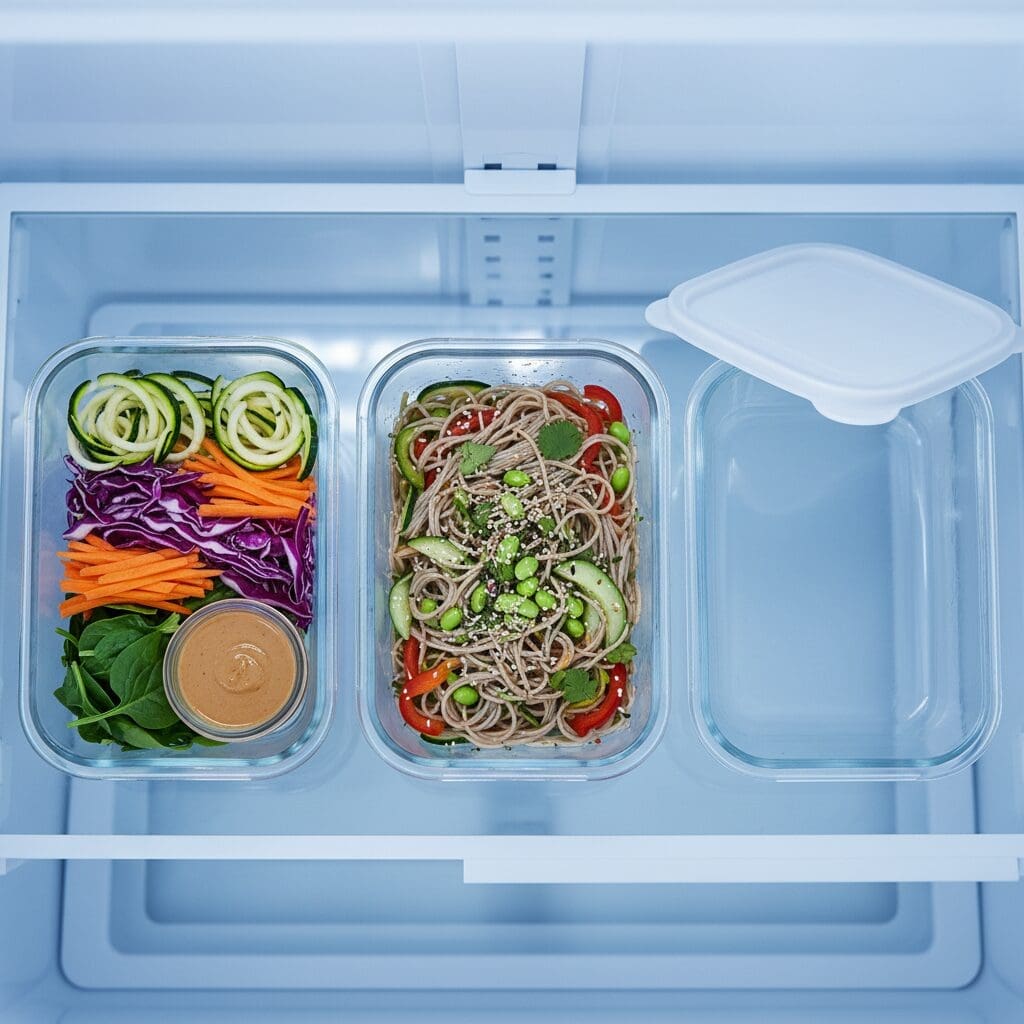
Gathering the ingredients is straightforward—no fancy grocery run required. This recipe serves 5 and focuses on whole, plant-based components for maximum flavor and nutrition.
I’ll break it down into the star players: the peanut sauce and the noodle mix-ins.
For the Peanut Sauce
- 1/2 cup natural peanut butter (unsweetened and unsalted for better control over flavors; it emulsifies smoothly without added oils that can make the sauce oily)
- 1/2 cup water (to thin it out—adjust for desired consistency)
- 1/4 cup low-sodium soy sauce or tamari (tamari for gluten-free; provides umami depth)
- 2 cloves garlic, minced (fresh for punchy aroma)
- 2 tablespoons fresh lime juice (or rice vinegar; adds bright acidity to balance richness)
- 3 tablespoons agave nectar or brown sugar (for subtle sweetness; agave keeps it vegan)
- 1 teaspoon Sriracha hot sauce (adjust for heat; builds that addictive spicy-sweet profile)
For the Noodles and Add-Ins
- 8 ounces spaghetti, rice noodles, or gluten-free pasta (long noodles cling best to the sauce; cook to al dente for texture)
- 1 cup shelled edamame (frozen and thawed; boosts protein to 19g per serving—edamame is a complete plant protein, according to USDA data)
- 1/2 cup chopped cucumbers (crisp and cooling; sub with sliced red cabbage for crunch)
- 1 cup shredded carrots (adds natural sweetness and beta-carotene for eye health)
- 1 red bell pepper, seeded and thinly sliced (vibrant color and vitamin C boost)
- 2 green onions, chopped (mild onion flavor)
- 1/4 cup chopped cilantro (fresh herb finish; omit if you’re not a fan)
- 1/4 cup chopped peanuts (for nutty crunch; skip for nut-free)
These ingredients create a balanced meal: carbs from noodles for energy, proteins and fats from peanuts/edamame for satiety, and veggies for vitamins. Total calories per serving: about 471, with 7g fiber to aid digestion.
How to Make Thai Peanut Noodles Step by Step

Making these noodles is as simple as it gets—no advanced skills needed. Follow these steps for foolproof results. Prep time: 10 minutes. Cook time: 5 minutes.
- Whisk the Peanut Sauce: In a medium bowl, combine the peanut butter, water, soy sauce, minced garlic, lime juice, agave, and Sriracha. Whisk vigorously until smooth and creamy. If it’s too thick, add a splash more water; too thin, a bit more peanut butter. This takes about 2 minutes and ensures even coating.
- Cook the Noodles: Bring a large pot of salted water to a boil. Add your chosen noodles and cook according to package instructions until al dente (usually 8-10 minutes for spaghetti). Drain well, but don’t rinse— the starch helps the sauce adhere.
- Prep the Veggies and Protein: While noodles cook, thaw edamame if frozen (microwave for 1 minute). Chop cucumbers, shred carrots (use a box grater or pre-shredded), slice bell pepper thinly, chop green onions, cilantro, and peanuts. This assembly-line approach saves time.
- Toss Everything Together: In a large serving bowl, add the drained noodles, edamame, all chopped veggies, and peanuts. Pour the peanut sauce over top. Use tongs or two spoons to toss gently until everything is well coated. The warmth from the noodles will slightly soften the veggies without cooking them.
- Serve Immediately: Divide into bowls and garnish with extra cilantro, peanuts, lime wedges, or a drizzle of Sriracha. Enjoy hot for the best texture!
Pro tip: Taste and adjust seasoning before serving— a squeeze of lime can brighten it up.
Expert Tips for the Perfect Peanut Noodles

After years of tweaking peanut-based recipes, I’ve gathered these insights to elevate your dish from good to gourmet. These tips address common pitfalls and enhance flavor.
- Sauce Consistency is Key: Natural peanut butter can separate, so stir it well before measuring. For a silkier sauce, blend ingredients in a food processor. If it thickens while sitting, whisk in warm water 1 tablespoon at a time.
- Noodle Texture Matters: Overcooked noodles turn mushy and dilute the sauce. Test a strand 1-2 minutes before package time. Rice noodles cook faster (3-5 minutes), so watch closely.
- Balance the Flavors: Taste the sauce alone first— it should be bold (salty, sweet, tangy, spicy). The veggies will mellow it. For authenticity, add a grated thumb-sized piece of fresh ginger to the sauce.
- Prevent Sticking: Toss noodles with a teaspoon of sesame oil post-drain if not saucing immediately. This keeps them separate without altering the taste.
- Boost Nutrition: To boost the protein, remember that edamame is a powerhouse. In fact, research from Harvard’s T.H. Chan School of Public Health shows it provides 17g of protein per cup. Pair with a side salad for more greens.
These tweaks, born from trial and error, ensure restaurant-quality results at home.
Creative Variations to Try
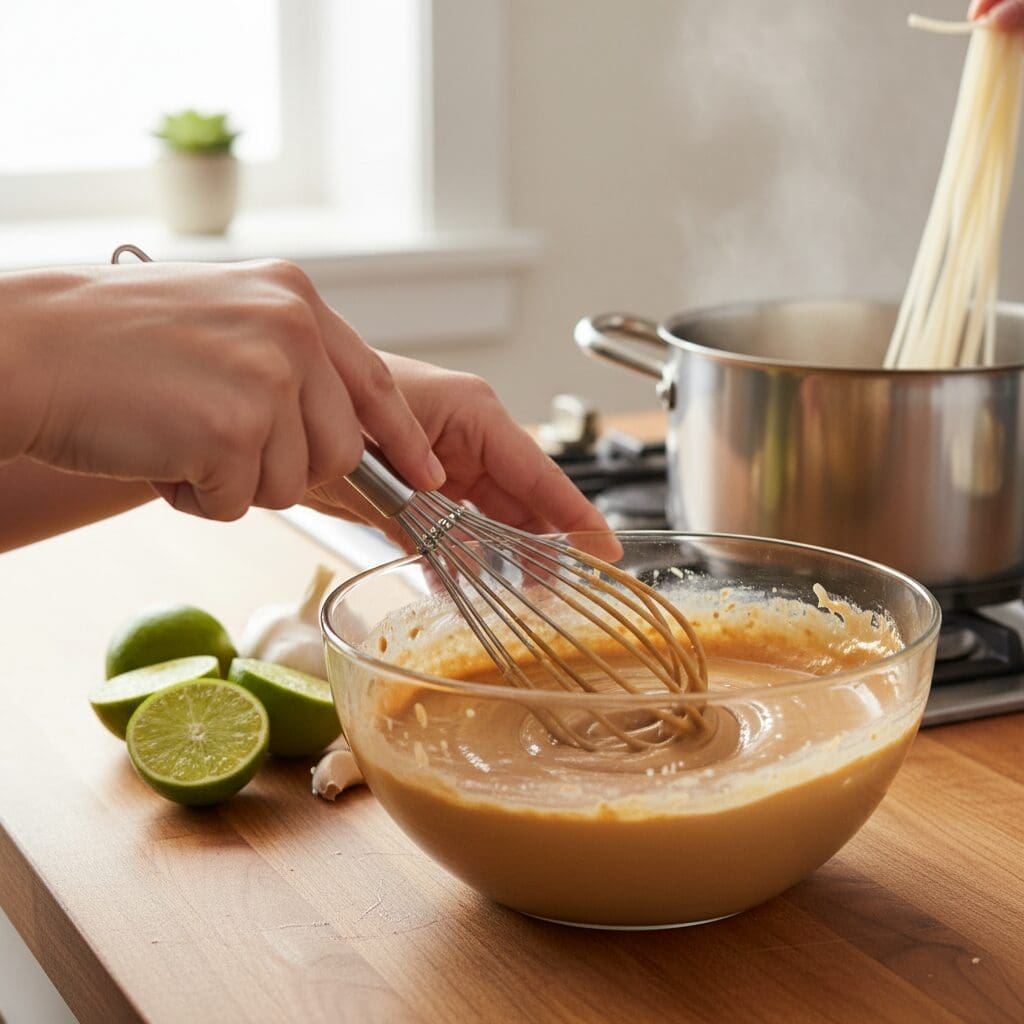
One of the joys of this recipe is its adaptability. Here are tested variations to keep things exciting:
- Spicy Sriracha Kick: Double the Sriracha and add 1/2 teaspoon crushed red pepper flakes for heat lovers. Top with sliced Thai chilies for extra fire.
- Protein Power-Ups: Swap edamame for air-fryer tofu cubes (crispy and absorbent), meaty mushroom-walnut crumbles, or shredded rotisserie chicken for non-vegans. Tempeh adds a nutty chew.
- Gluten-Free Glory: Use tamari and brown rice noodles. For a grain-free twist, spiralize zucchini into ‘zoodles’ and lightly steam them.
- Veggie Remix: Incorporate baby bok choy, snow peas, or spinach for greens. In summer, add halved cherry tomatoes for juiciness.
- Make it a Bowl: Serve over quinoa or cauliflower rice for a low-carb version, turning it into a peanut quinoa salad.
Each variation maintains the 15-minute timeline while targeting different dietary needs. Experiment based on your pantry— the peanut sauce pairs with almost anything.
Serving Suggestions and Pairings
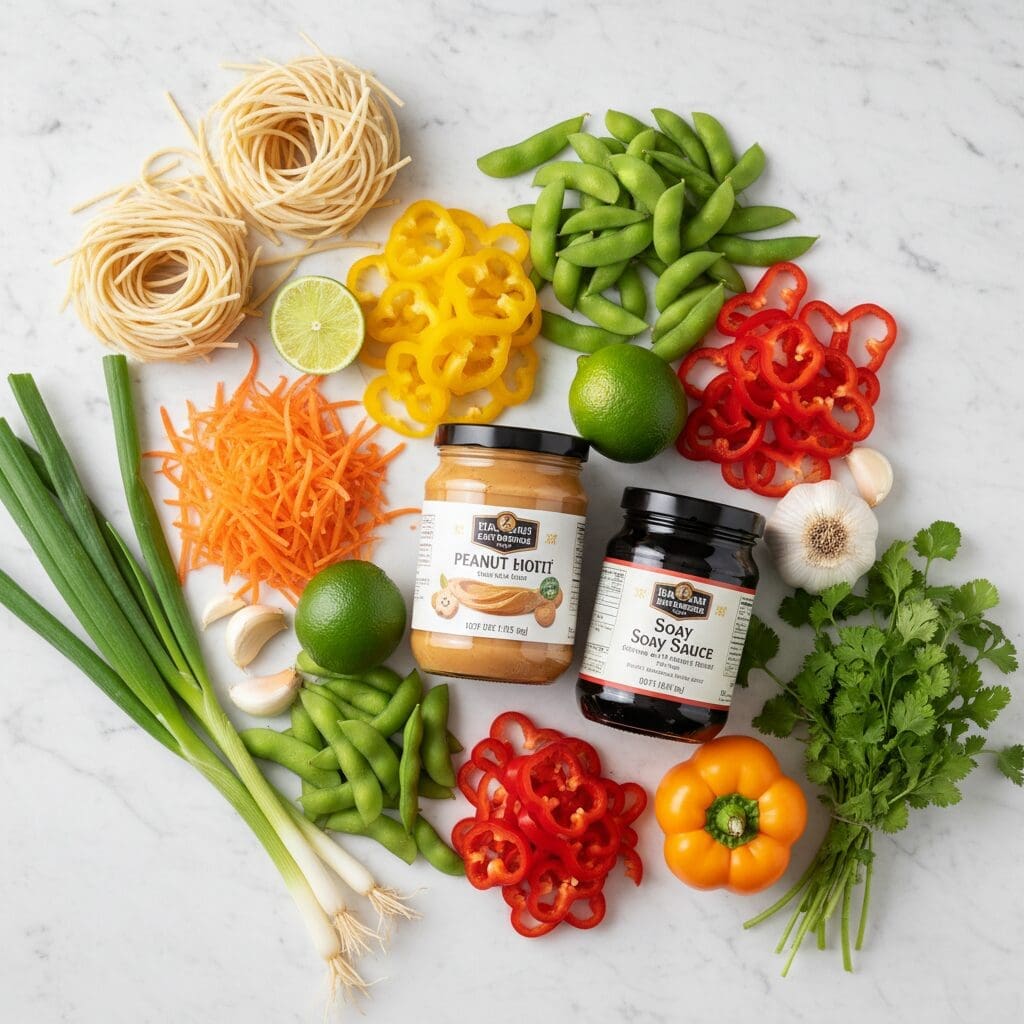
These noodles shine solo but elevate with thoughtful sides. Aim for contrast: cooling, crunchy, or fresh elements to complement the rich sauce.
- Simple Starters: Cucumber salad with rice vinegar or fresh spring rolls with peanut dipping sauce (reuse leftovers!).
- Balanced Sides: Steamed broccoli or a green papaya salad for added vitamins. A side of mango slices cuts through the savoriness with tropical sweetness.
- Drinks to Match: Iced green tea or a coconut water lime spritzer refreshes the palate. For adults, a crisp Thai beer like Singha pairs perfectly.
- Meal Prep Hack: Portion into jars for grab-and-go lunches— sauce at the bottom prevents sogginess.
Serving warm in shallow bowls highlights the steam and aromas, encouraging family-style sharing. This setup turns a quick recipe into a mini feast.
Storage, Freezing, and Meal Prep Tips
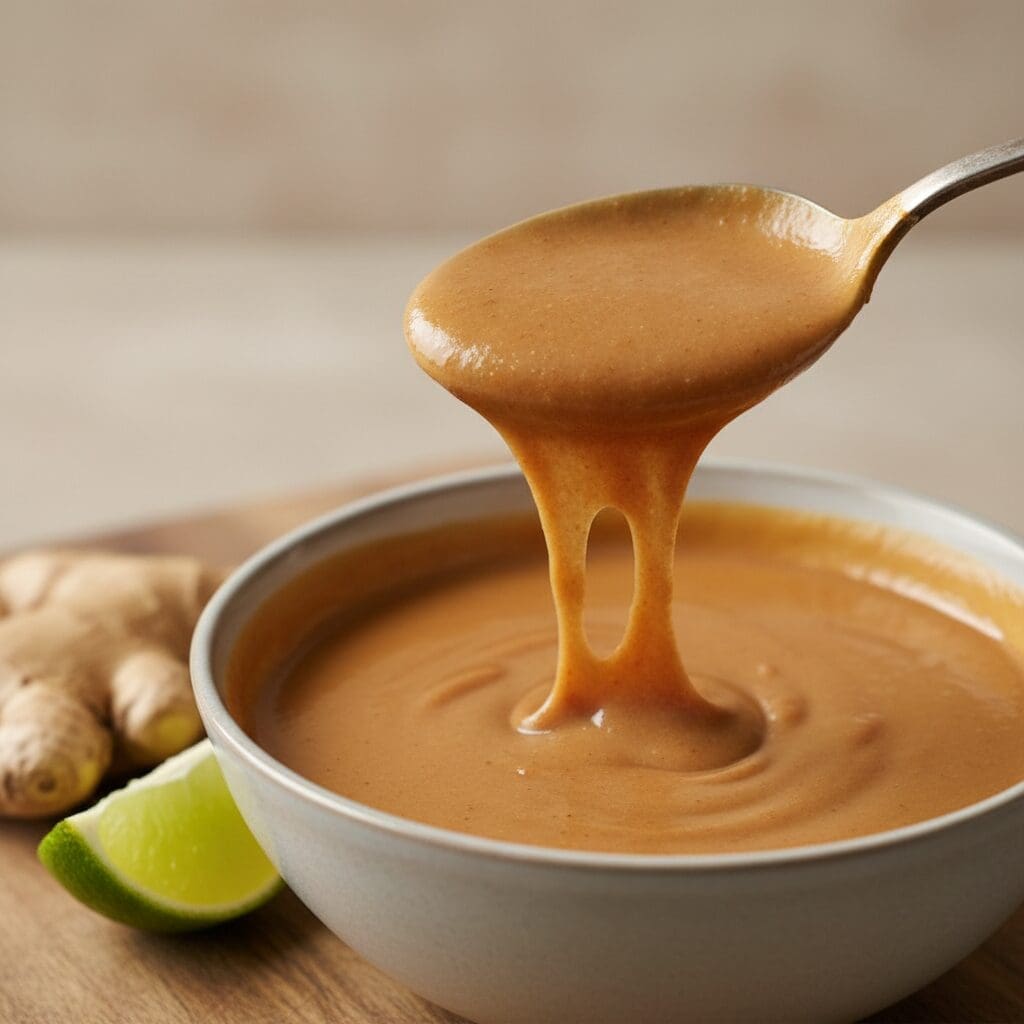
This dish is meal-prep friendly, but proper storage preserves quality.
- Refrigerator Storage: Cool completely, then store in airtight containers for up to 3-4 days. The sauce may thicken; loosen with a splash of water or lime juice when reheating.
- Reheating Best Practices: Microwave in 30-second bursts, stirring midway, or stovetop with a bit of water over low heat. Avoid high heat to prevent drying.
- Freezing Advice: Noodles don’t freeze well due to texture changes, but make and freeze the sauce separately in ice cube trays for up to 2 months. Thaw and toss with freshly cooked noodles.
- Meal Prep Pro Tips: Chop veggies ahead and store separately to maintain crunch. Assemble cold for salads or heat for hot meals. Yields great packed lunches—nutritious and portable.
Following these keeps the flavors vibrant, reducing waste and saving time during the week.
Frequently Asked Questions
Got questions? I’ve answered the most common ones based on reader feedback.
How can I make these noodles spicier?
Amp up the Sriracha in the sauce to 2 teaspoons or more, and sprinkle red chili flakes on top. For authentic heat, infuse the sauce with fresh minced Thai bird’s eye chilies.
Is this recipe gluten-free?
Yes, with swaps: use tamari instead of soy sauce and gluten-free noodles like rice or quinoa-based ones. Always check labels for cross-contamination.
How long do leftovers last?
Up to 3-4 days in the fridge. They reheat well but may need extra liquid to revive the sauce.
Can I freeze the peanut noodles?
The full dish doesn’t freeze well due to noodle sogginess, but the sauce freezes excellently. Portion into bags for future use.
What if I don’t have edamame?
Substitute with chickpeas, hearty lentils, or even canned black beans for protein. For a non-vegan option, diced chicken or shrimp works too.
Why use natural peanut butter?
It avoids added sugars and oils, allowing better flavor control and a creamier texture when whisked.
Conclusion
Thai Peanut Noodles are more than a recipe—they’re a lifeline for busy days, proving that delicious, healthy eating can be simple and joyful. With its creamy sauce, crisp veggies, and satisfying chew, this dish has won over countless home cooks, including my own family.
Give it a try tonight; I promise it’ll become a staple. Share your twists in the comments or tag me on social—happy cooking!
